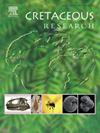Age and palaeoenvironmental constraints on the earliest dinosaur-bearing strata of the Densuș-Ciula Formation (Hațeg Basin, Romania): Evidence of their late Campanian-early Maastrichtian syntectonic deposition
IF 1.7
3区 地球科学
Q1 GEOLOGY
引用次数: 0
Abstract
The Haţeg Basin is famous for its rich uppermost Cretaceous continental vertebrate assemblages, with some of the most important ones originating from the Densuş-Ciula Formation. The present study aims to provide a more accurate picture of the geological and palaeoenvironmental context of this important dinosaur-bearing succession through complex spatial analysis based on detailed geological mapping combined with results of zircon U–Pb geochronology, sedimentology, vertebrate palaeontology and micropalaeontology investigations. This integrated stratigraphical survey revealed that the important environmental shift from marine to continental deposition in western Haţeg Basin occurred significantly earlier (by middle late Campanian) than hitherto considered, and that the lower Densuș-Ciula Formation – previously thought to be restricted to the Maastrichtian – covers a good part of the upper Campanian as well. Sedimentological investigations, aimed to characterize palaeoenvironmental changes during basin evolution, identify two, vertically superimposed fining-upward successions within the lower Densuș-Ciula Formation, reconstructed as alluvial fan environments linked to distinct stages of basin tectonic evolution. Contrary to previous interpretations as a post-orogenic molasse, the lower Densuș-Ciula Formation is here re-interpreted as a largely syntectonic unit deposited in a transtensional, dextral strike-slip basin initiated during the late Campanian. The stratigraphic positions and palaeoenvironmental settings of all major vertebrate sites from this area are re-assessed using our new age constraints and improved tectonic-stratigraphic-sedimentologic framework, documenting a significantly earlier start of the accumulation of vertebrate-bearing deposits than thought before, and challenging previous ideas about the timing of assembly, isolation and evolution of the Haţeg Island faunas.
罗马尼亚Hațeg盆地Densuș-Ciula组最早恐龙地层的时代和古环境约束:坎帕尼亚晚期-马斯特里赫特早期同构造沉积的证据
Haţeg盆地以其丰富的白垩纪上部大陆脊椎动物组合而闻名,其中一些最重要的脊椎动物来自densu - ciula组。在详细的地质填图基础上,结合锆石U-Pb年代学、沉积学、脊椎动物古生物学和微体古生物学的调查结果,通过复杂的空间分析,更准确地描绘出这一重要的恐龙序列的地质和古环境背景。综合地层学调查表明,Haţeg盆地西部由海相沉积向陆相沉积的重要环境转变发生的时间明显早于迄今为止所认为的中晚期坎帕纪,并且先前认为局限于马斯垂纪的下Densuș-Ciula组也覆盖了很大一部分上坎帕纪。沉积学研究旨在描述盆地演化过程中的古环境变化,在Densuș-Ciula组下部确定了两个垂直叠加的向上细化序列,并将其重建为与盆地构造演化不同阶段相关的冲积扇环境。与以往的造山后的molasse解释相反,Densuș-Ciula组下部在这里被重新解释为一个主要的同构造单元,沉积在晚坎帕尼亚期开始的张拉、右旋走滑盆地中。利用新的时代约束和改进的构造-地层-沉积框架,对该地区所有主要脊椎动物遗址的地层位置和古环境背景进行了重新评估,记录了比以前认为的更早开始积累脊椎动物沉积物的时间,并挑战了先前关于Haţeg岛动物群集合,隔离和演化时间的观点。
本文章由计算机程序翻译,如有差异,请以英文原文为准。
求助全文
约1分钟内获得全文
求助全文
来源期刊

Cretaceous Research
地学-地质学
CiteScore
4.10
自引率
19.00%
发文量
235
审稿时长
12 weeks
期刊介绍:
Cretaceous Research provides a forum for the rapid publication of research on all aspects of the Cretaceous Period, including its boundaries with the Jurassic and Palaeogene. Authoritative papers reporting detailed investigations of Cretaceous stratigraphy and palaeontology, studies of regional geology, and reviews of recently published books are complemented by short communications of significant new findings.
Papers submitted to Cretaceous Research should place the research in a broad context, with emphasis placed towards our better understanding of the Cretaceous, that are therefore of interest to the diverse, international readership of the journal. Full length papers that focus solely on a local theme or area will not be accepted for publication; authors of short communications are encouraged to discuss how their findings are of relevance to the Cretaceous on a broad scale.
Research Areas include:
• Regional geology
• Stratigraphy and palaeontology
• Palaeobiology
• Palaeobiogeography
• Palaeoceanography
• Palaeoclimatology
• Evolutionary Palaeoecology
• Geochronology
• Global events.
 求助内容:
求助内容: 应助结果提醒方式:
应助结果提醒方式:


